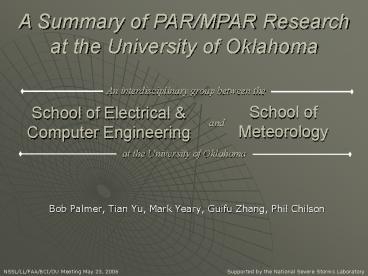School of Electrical
1 / 17
Title: School of Electrical
1
School of Electrical Computer Engineering
A Summary of PAR/MPAR Researchat the University
of Oklahoma
An interdisciplinary group between the
School of Meteorology
and
at the University of Oklahoma
- Bob Palmer, Tian Yu, Mark Yeary, Guifu Zhang,
Phil Chilson
Supported by the National Severe Storms Laboratory
NSSL/LL/FAA/BCI/OU Meeting May 23, 2006
2
Project Overview
3
Next Generation Radar Simulator for Advanced
Signal/Array Processing Studies
Example simulator output with mixed weather and
point target
Standard Beamforming
- Would like to develop/study advanced signal/array
processing algorithms using realistic, Level-I,
time-series radar data - Real experimental data are not controlled or
flexible - Solution is an advanced radar simulator using
high-resolution numerical weather simulation data
as input fields
Point Target
Adaptive Beamforming
Weather
Simulated multi-function phase array antenna 155
elements 17 degree coverage 10,000 scatterers
Possible Applications
- Multi-function (weather surveillance and target
tracking) - Neural network training under varying conditions
- Simulation of advanced radar designs (phased
arrays, multi-frequency, etc.) - Filter design for clutter mitigation
- Resolution enhancement using interferometry/deconv
olution - Optimization of beam scanning strategies using
phased array radars
Conceptual diagram of model-based radar simulator
capable of simulation of realistic, complex
time-series data
R. Palmer, B. L. Cheong
4
Project Overview
5
Overview of OUs Refractivity Retrieval Algorithm
Phase measurement for a map of reference phase
Phase measurement during operational time
A map of Phase Difference ??
Image Processing Clutter Quality, Masking,
Smoothing
Radial gradient ? ?N
R. Palmer, B. L. Cheong, C. Curtis
6
Refractivity ChangeNWRT-PAR (Sept 28, 2005)
7
Comparison Between KOUN and PAR
PAR Refractivity
KOUN Refractivity
Different Radars and Different Algorithms
8
Project Overview
9
NSSL has activated the azimuth difference channel
Crossbeam wind, shear and turbulence measurement
- SPY-1 three channels
- Sum
- Azimuth difference
- Elevation difference
Spaced Antenna (SA)
Azimuth SA
Elevation SA
G. Zhang, D. Doviak, NSSL engineers
10
Measures apparent wind consist of crossbeam wind
and shear
Theoretical understanding and numerical
simulations
Crossbeam wind causes signal delay
Shear also causes signal delay
11
Project Overview
12
Target Tracking Emerging Non-Linear Stochastic
State Estimation Techniques
Networked tracking algorithms based on particle
filtering will provide improvements to these
areas that require the analysis of dynamic
movements, particularly when the underlying
dynamic models are non-linear and when the
measurement noise is non-Gaussian. As discussed
in the most recent literature, particle filtering
is defined as an emerging Bayesian method based
on sequential Monte-Carlo non-linear state
estimation techniques.
Left PAR detections made in a 90o sector
looking towards the OKC airport, Sept 15, 2005.
Right Specific tracks are formed for data
collected Sept 19, 2005.
- Why is particle filtering important for PAR?
- Tracking in the presence of strong maneuvers. As
seen above, when the object denoted by the green
curve makes a sharp change in course,
conventional techniques (such as the Extended
Kalman Filter) cannot maintain track. - One step ahead prediction algorithms for optimum
beam-steering
M. Yeary, G. Mitchell (BCI)
13
Some initial results
14
Project Overview
15
System Optimization Beam Multiplexing (BMX)
Beam multiplexing (BMX) optimize the use of radar
resources and data quality by collecting
independent samples
T. Yu, C. Curtis, D. Zrnic, D. Forsyth
16
System Optimization Beam Multiplexing (BMX)
17
Summary
- Have established an active collaboration between
OU and NSSL focused on PAR-related research - Conducting research in the following areas
- Refractivity retrieval
- Cross-beam wind estimation
- Beam multiplexing
- Array processing
- Target tracking algorithms
- Waveform design
- Integration of research activities with
cross-disciplinary educational program - Near-term plans include cross-beam wind
implementation, new PAR tracking data, simulator
refinement for pulse compression, etc.































